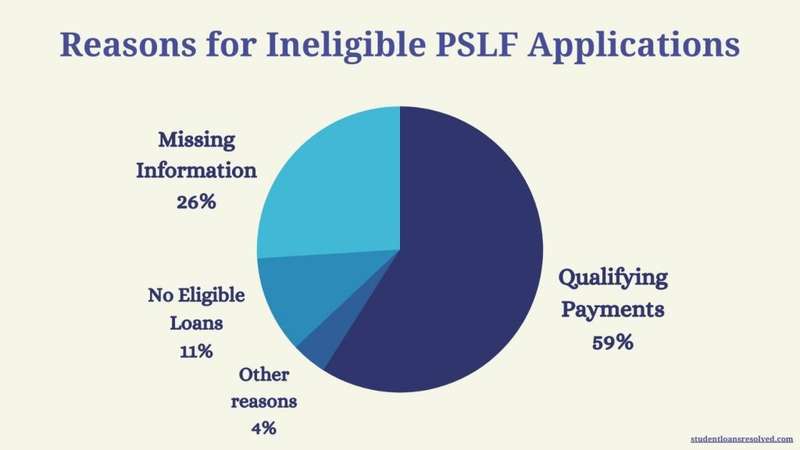Public Service Loan Forgiveness is a compelling debt forgiveness opportunity for those serving the nation. Borrowers in governmental organizations or non-profit establishments are welcomed to apply this program to get 100% debt elimination.
Currently, 70% of applicants fail the application. Read this guide carefully to maximize your chance and be among the lucky 30%!
Eligibility Conditions
We understand reading all details of eligibility can be boring. However, according to Student Aid data, in 2020 (November), around 70% of Public Service Loan Forgiveness applications failed. The most common reasons for failure are the followings:

If a borrower is well aware of the requirements, it is hard to fail the PSLF application. For example, 11% of the applications failed due to ineligible loans. If you know which loans qualify for this forgiveness program, you will not waste ten years making payments for an ineligible loan.
In short, check the following eligibility requirements carefully, but make sure you get expert help before application to maximize your chance to qualify for the PSLF.
The Right Employer
If you want to eliminate your student debt through Public Service Loan Forgiveness, you have to work in a qualifying workplace. As its name suggests, public service qualifies for forgiveness, and it can be provided in:
- Tribal, local, state, or federal government organization
- Tax-exempt non-profit organization
Keep in mind that tax exemption is determined through Section-501-c-3 of the Internal Revenue Code. If you are not sure if your non-profit employer qualifies for this forgiveness program, you can use the PSLF help tool on the Student Aid website to determine eligibility. For further information, if you work for a labor union, partisan political organization, or non-qualifying not-for-profit organization, your application will not be successful. Besides, AmeriCorps or Peace Corps volunteers can take advantage of this program.
You can check more options for AmeriCorps volunteers in this article: AmeriCorps Student Loan Forgiveness and Other Benefits for Members.
For Non-profit Employees
Besides governmental organizations, Public Service Loan Forgiveness is a unique program benefiting employees in non-profit organizations. If you work in a not-for-profit organization, you can progress toward forgiveness by making 120 qualifying payments.
Your employment automatically qualifies to the program, so you do not need to be worried about workplace requirements. However, make sure you have a full-time job or multiple part-time positions, together with making qualifying payments- on time, in full amount, and under Income-driven repayment plans.
Check this guide for more information: Non-profit Student Loan Forgiveness and What to Expect in 2021?
Suitable Work Hours
Public Service Loan Forgiveness requires borrowers to work full time. Full-time work is a minimum of 30 hours per week, but the employer can also define it. If your job is half-time, do not worry. If you can get two or more positions that totals 30 hours weekly, you will qualify for the forgiveness.
Keep in mind that time spent on worshipping, religious instructions, or proselytizing might not count as a part of work hours.
Eligible Loans
As mentioned, if you know what types of loans qualify for Public Service Loan Forgiveness, you will not be among 11% of failed applicants. Direct loans are eligible for the PSLF:
- Direct Consolidated Loans
- Direct Subsidized / Unsubsidized
- Direct Stafford Subsidized / Unsubsidized
- Direct PLUS
Unfortunately, FFEL, Perkins, or private loan borrowers should not apply for this forgiveness program.
If you want to benefit from consolidation to simplify payments, you need to be careful. Consolidation is not a barrier for PSLF; however, only the payments after the consolidation will be counted. If you made payments before consolidation, you would lose them.
What if My Federal Loans Don’t Qualify?
Luckily, there is a method to turn your federal loans into Direct Loans so that they can qualify under PSLF. The Direct Loan Consolidation program operates by taking every federal student loan and combining them into one new Direct Loan.
If you do not have Direct Loans and still need to apply for Public Service Loan Forgiveness, you must consolidate your loans in this form.
Qualifying Payments
Another important eligibility condition defines how you should make 120 payments. Not all payments are counted for the Public Service Loan Forgiveness. For example, previously, we mentioned that payments before consolidation would be ignored.
Besides this condition, the payments should be in a full amount which you can find on the bills. You have to pay the bill within 15 days after the due date; otherwise, you will miss a payment. Moreover, you need to enroll in an Income-driven repayment plan to make payments. You can choose among different eligible plans such as:
- Pay as You Earn
- Revised Pay as You Earn
- Income-based Repayment
- Income-contingent Repayment
Borrowers are free from debt repayment during the study period and around six months after graduation, defined as a grace period.
Other Advantages of Enrolling in the Income-Based Programs
Under the income-based programs, your payments are determined based on your income, not on how much you owe. This can usually give borrowers relief from high amounts they are oppositely unable to make. In some examples, the monthly payment could be as low as $0.00 per month for those with little income. However, the rate also depends on the income and family size of the candidate. Despite how little it is (even $0.00), the amount would count towards your forgiveness.
Application Process
Public Service Loan Forgiveness requires 120 qualifying payments. It means you need to repay the debt for at least 120 months or ten years. It is a long period, and it can be hard to track the payments.
For this purpose, the borrowers should fill the PSLF form, which also involves Employment Certification. The loan servicer uses this form to check the payments and determine how many qualifying payments the borrower has. If you do not submit this form periodically or when you change employers, you have to submit one or more PSLF forms at the time of application.
You can fill the form through the PSLF Help Tool or by downloading the form and filling it manually. Once the form is completed, it should be sent to FedLoan Servicing or faxed. Below you can find the relevant information:
U.S. Department of Education
FedLoan Servicing
P.O. Box 69184
Harrisburg, PA 17106-9184
For fax: 717-720-1628
Keep in mind that during the 120 payment period and even at the time of application, you should work for a qualifying employer.
Temporary Expanded Public Service Loan Forgiveness
If some or all of your payments do not qualify for the PSLF, under the regular specifications for a limited time, you could still be eligible for PSLF.
The Temporary Expanded Public Service Loan Forgiveness chance offered by the U.S. Department of Education temporarily amends the current program to add more borrowers.
The TEPSLF opportunity prolongs the list of repayment programs under which you can make your 120 needed payments. TEPSLF allows these types of repayment plan while PSLF only accepts payments made under an IDR plan:
- Graduated Repayment Plan
- Extended Repayment Plan
- Consolidation Standard Repayment Plan
- Consolidation Graduated Repayment Plan
If PSLF has rejected you because of non-qualifying payments or if you’ve made payments that don’t qualify for PSLF, it’s necessary to learn more about the Temporary Expanded Public Service Loan Forgiveness chance and check out if you qualify.
Temporary Expanded PSLF is a limited opportunity and will be given to applicants on a first-served basis, first-come, so it’s necessary to apply as soon as possible if you’re eligible.
Public Service Loan Forgiveness in 2021
Forgiveness programs emerge, develop, and cancel. Luckily, for Public Service Loan Forgiveness, the end seems far enough. Although the program is considered complex rather than canceled, the government aims to improve it. President Joe Biden suggested changing the Public Service Loan Forgiveness structure and granting $10,000 per service year, rather than waiting for ten years. According to his plan, borrowers would be able to benefit from this forgiveness opportunity a maximum of five times. It means the maximum limit of the Public Service Loan Forgiveness can be $50,000.
- On the bright side, the program will become more accessible as you do not need to wait for ten years.
- On the dark side, you will get only $50,000 forgiveness, while now the whole remaining balance (without a limitation) is discharged after 120 payments.
However, keep in mind that these are only suggestions. These recommendations need to be presented and get approval from Congress so that they are put into law.
For this and more expected changes in federal student aid programs, check our guide: Joe Biden’s Student Loan Plan: What can Change in 2021?
Other Forgiveness and Discharge Options
Although Public Service Loan Forgiveness is an attractive option with its unlimited debt discharge opportunity, not everyone qualifies for it. If you think the PSLF is not the right option for you, you can check other federal aid programs like;
- Teacher Loan Forgiveness
- Perkins Loan Forgiveness
- Perkins Loan Discharge
- Borrower’s Defense to Repayment
- Closed School Discharge, etc.
Each of these options has its benefits and drawbacks. Before you make any decision, it is advisable to get familiar with all details and, if possible, to request an expert’s help. Like those in Student Loans Resolved, debt specialists can analyze your finances and develop a sound debt resolution strategy. We offer a FREE Consultation for your questions and concerns.
Read this guide to fully explore your debt forgiveness options: Cancel Student Loan Debt: 12 Ways to End Your Payments in 2021
FAQ
How Much Debt Can be Forgiven through the PSLF?
For now, there is no maximum number that can be forgiven under PSLF. If Biden’s suggestions are put into the law, the maximum limit can be $50,000.
Is Public Service Loan Forgiveness Taxable?
No. Any amount forgiven under the PSLF is not considered taxable income for the Internal Revenue Services.
What Happens if I Have Two Jobs in Public Service?
If you work in non-profit jobs or a separate public sector, you are considered to match the necessity for full-time employment if the combined hours at both positions are 30 hours or more per week.
Do Payments Have to be Consecutive?
No. You have to make 120 qualified payments for PSLF to work, but they do not have to be made continuously. Therefore, it will take at least ten years to qualify for PSLF, but it may take longer.
Is PSLF Being Cancelled? What Should I Do?
PSLF has been the subject of some discussion previously. The current developments show that Public Service Loan Forgiveness is here to stay. Yet, it is advisable to follow the announcements and news regarding the PSLF decisions.
Are the Qualifying Payments Retro-Active?
Yes! You could qualify for loan forgiveness if you meet all the qualifying standards of PSLF and have been making qualifying payments for ten years. There is no specification to access the PSLF program, only that you apply at the end of your ten years of qualifying payments, employment, and having the correct loan standards.
Can I Receive Forgiveness Faster than 10 Years?
Unfortunately, no. Do not try to make payments in higher amounts to get more credits toward 120 credit for the forgiveness. Only 120 payments in 120 months are eligible, and it is the minimum period required.

